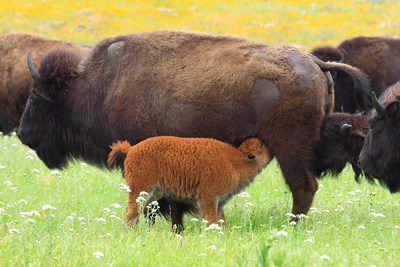Last updated: November 6, 2017
Article
Bison Bellows: Birth of K-selected Species

Photo courtesy of Beth Bishop.
As the summer flowers begin to appear and the days start to warm, the prairie ecosystem is soon dotted with newborn bison. These young calves, born mostly between March and June, are born with an orange-brown to reddish-brown "buff" color, which slowly darkens to adult coloration by four months. At the time of birth, bison calves can weigh on average between 33 to 66 pounds (15-30 kg). Within 30 minutes of birth, newborns can stand and nurse, and within a couple of hours, they will begin to travel with the rest of the group. By the time they are completely weaned of their mother's milk around 7 to 12 months, bison calves can weigh between 350 to 425 pounds (160-190 kg)---the weight of a full-grown male lion!
For species with low reproductive rates and long lifespans, such as the American bison, the survival of both adult females and their young ultimately influences population growth. Survival is based on the species' habitat, reproductive success, survival strategies, and competition with other organisms. Species have evolved specific life history strategies (k and r-selected) to ensure the growth and evolution of their species. K-selected species possess relatively stable populations fluctuating near the carrying capacity of the environment. These species are characterized by having only a few offspring but investing high amounts of parental care. Elephants, humans, and bison are all k-selected species. On the other hand, r-selected species often inhabit unstable environments and are completely density independent. These species often have short life expectancies, produce as many offspring as they can, and invest very low amounts of parental care. R-selected species can include mosquitos, mice, and bacteria.
In terms of the American bison as a k-selected species, the gestation period for bison is 9.5 months or roughly 285 days---only five days longer than the gestation period for humans. After females reach sexual maturity around the ages of two or three years, female bison generally give birth to one calf every one to three years until they reach the age of 16. Twins do occur, but only on extremely rare occasions. Also, the longest mother-calf associations are with female offspring and this maternal investment can last into the second summer. This type of strategy would definitely not work for E. coli bacteria that have a generation time of minutes!
